Physical Address
304 North Cardinal St.
Dorchester Center, MA 02124
With increasing numbers of persons from industrialized, temperate countries traveling and / or working in tropical lands, there is a marked need for physicians to be able to diagnose accurately and treat tropical diseases with mucocutaneous manifestations. While some studies demonstrate that approximately one-third to two-thirds of travelers returning from tropical countries experience some health problem, diarrhea is the most prevalent complaint. Mucocutaneous problems, however, are among the top five health complaints of the returned traveler, and comprise 10–15% of health concerns of persons returning from the tropics.
During international conflicts, soldiers from North America, Europe, and Australia are often required to serve in tropical lands and sometimes develop diseases not familiar to physicians of their home countries. This was the case for French soldiers serving in Vietnam in the 1950s and American soldiers serving there in the 1960s and 1970s. Recently hundreds of American and allied troops serving in Iraq and Afghanistan have developed “Baghdad boils” (i.e., leishmaniasis), transmitted by sand fly bites ( Fig. 1-1 ).
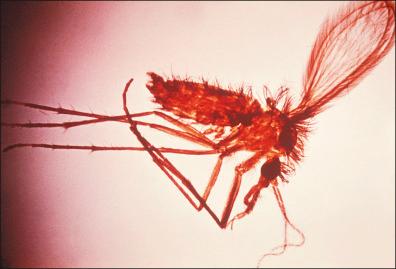
Likewise, millions of persons from tropical countries now live and work in temperate lands and may present with medical problems with which the physician is not familiar. Whereas the cutaneous problems in the returned traveler are frequently the result of infectious diseases, skin diseases of non-infectious etiologies usually predominate. Such non-infectious sources of skin problems include excessive sun exposure, cutaneous reactions to medications taken for prophylaxis (including phototoxic reactions) or exposures to marine, freshwater, or other irritants. Furthermore, whether it is the traveler or the immigrant presenting to the physician, many cutaneous complaints are unrelated to the person's travel or national origin, but are the same conditions seen daily in every physician's office. Therefore, the physician should not ignore the common sources of dermatologic problems while searching for an exotic etiology.
Another, somewhat recent, source of patients with tropical skin diseases is adoptees who frequently originate in Central America or Southeast Asia. These children could be infected with organisms having a long incubation period that may not have been detected by physical examinations and are not preventable by available vaccines.
Tropical infections in temperate lands, however, are not totally unique to travelers. For example, the outbreak of monkeypox in Wisconsin, USA, in 2003 was a result of prairie dogs acquiring the virus from Gambian rats housed in adjacent cages in pet stores. The prairie dogs then transmitted the infection to humans who had never been near the usual range of monkeypox (i.e., central Africa).
Occasionally, the patient with a tropical disease is neither the traveler nor someone exposed to an animal carrying an infectious agent. The carrier may be a friend or relative who is a returned traveler who has acquired a tropical infection and who has not yet developed signs or symptoms. This possibility has recently been given much attention due to the potential spread of severe acute respiratory syndrome (SARS), which originated in China in 2002, Middle East respiratory syndrome (MERS), first reported in Saudi Arabia in 2012, or avian influenza virus. On the other hand, contaminated food may have originated in a tropical or subtropical area, such as when oysters from the Gulf of Mexico are shipped to the Midwest USA and are consumed raw. The resulting Vibrio vulnificus or hepatitis A infection thus produces gastrointestinal and cutaneous manifestations in individuals who may not have visited the source of the shellfish. Therefore, it is always important to ask about new pets, changes in diet, or any other change in persons with a suspected tropical disease. On the other hand, travelers may have purchased non-consumable items that are the source of their dermatoses. For example, animal skins used for rugs or blankets may be the source of anthrax. A non-infectious cause may include nickel-containing jewelry to which the patient has developed contact dermatitis.
Whereas travelers naturally fear large carnivores while on camera safari, or sharks and a variety of other aquatic animals while swimming or diving, it must be remembered that the animal (indirectly) responsible for most morbidity and mortality is the mosquito (i.e., malaria, dengue, etc.) ( Fig. 1-2 ). An example of a mosquito-borne disease that was considered primarily “tropical” in the recent past but is now relatively common in much of North America is infection with the West Nile virus ( Fig. 1-3 ).
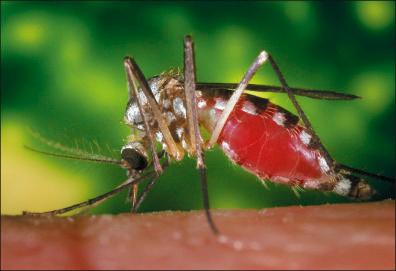
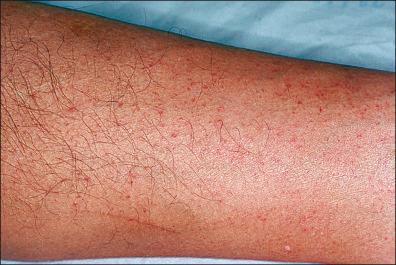
Sometimes the skin findings on physical examination are not the reason for the visit to a physician or even the patient's complaint. Such skin findings may be cultural, such as tattoos or scarification, or the result of the use of kava or of chewing betel nuts. Some cultural practices, however, would be considered abuse in industrialized countries, but are widely accepted religious / cultural practices in certain lands. An example of such practice is female circumcision, which is practiced in many countries in sub-Saharan Africa. On the other hand, the skin changes may be much more benign, transient, and may even be the result of previous therapies, such as cupping and coining, widely practiced by immigrants from Southeast Asia.
Considerations for deciding the differential diagnosis of cutaneous manifestations of tropical diseases and / or of diseases acquired while traveling must be based not only on the type of lesions and systemic symptoms but also on the patient's history of travel. Because the incubation period of various infectious diseases differs widely, it is important to know when the person traveled. For frequent travelers, the history may become complex if patients report having visited many destinations within the past few months. Because vectors differ with the climate, the season of travel is also noteworthy. Even in a tropical country where the temperature is always hot or warm, there may be a dry season and a rainy season. Because seasons are reversed north and south of the Equator, it is important to know the season at the destination. The duration of the stay is significant, not only because a longer stay increases the chance of acquiring an infectious disease, but also because it tells the physician whether the person was in the tropics during the incubation period of the suspected disease. Whether the visitor was only in an urban environment or also in a rural area is relevant. Whereas a sexually transmitted disease (STD) could be acquired in either location, an arbovirus or a zoonosis might be more likely in a rural situation. The altitude of the destination could provide a clue to the etiology of the skin condition, as could the type of sleeping condition. For example, a sexually transmitted disease could easily be acquired in a five-star hotel, but an infection transmitted by a flea, louse, or mite would be more likely in someone who had slept on the ground and / or in a tent.
The type and preparation of food and drink consumed by the traveler would not only help explain gastrointestinal symptoms, but could also be a clue to cutaneous signs (i.e., unsafe drinking water or milk or raw or undercooked meat, fish, or shellfish).
A list of the patient's current and recent medications can be very useful and should include prescription drugs, illicit drugs, and herbal remedies, because the source of the cutaneous problem may not be directly related to the travel destination, but rather may be due to medications taken to prevent travel-related illnesses. For example, many antimalarials, such as chloroquine, mefloquine, proguanil, quinine, and halofantrine, can cause cutaneous reactions, and chloroquine, doxycycline, and quinine can cause photosensitivity. Interestingly, chloroquine can worsen psoriasis. A number of agents taken to treat or prevent diarrhea can also cause cutaneous reactions, such as quinolones (ciprofloxacin, ofloxacin, sparfloxacin, levofloxacin), furazolidone, metronidazole, trimethoprim-sulfamethoxazole and bismuth sulfate; quinolones are particularly likely to produce photosensitivity. Anthelmintic medications, such as ivermectin, albendazole, and diethylcarbamazine, can also produce pruritus and rash. Even diethyltoluamide (DEET), used to prevent arthropod bites, can cause an irritant dermatitis when used in high concentrations.
Because many medications in tropical countries are sold over the counter and / or have different trade names to those in industrialized lands, patients are not always certain what they have received if treated during their travel. Likewise, an injection or transfusion given in a tropical country might also carry an increased risk of contamination. A similar risk might be taken by having acupuncture, tattoos, or body piercing in tropical lands, but these procedures can be hazardous even in industrialized countries because the first intervention is occasionally done by non-medical personnel and the other two are almost never done by medically trained persons.
A history of pretravel vaccinations and / or immunoglobulins would be useful for possible exclusion of certain suspected etiologies. For example, if the yellow fever vaccine and the hepatitis A and / or B vaccine series were administered in sufficient time before the travel, it is less likely that these viruses were the source of the medical complaint.
The traveler's occupational or recreational exposure to dirt, water, or animals can be an important component of the history. An animal bite or scratch should be easy to remember, but the bite of many arthropods may not even be noticed until after a cutaneous reaction has appeared and the fly, mite, or flea that is responsible has moved on to the next victim. Exposure to some animals may be more indirect. For example, the spelunker (cave explorer) may inhale aerosolized bat guano and develop rabies without ever touching a bat. A history of swimming, boating, or surfing can be a clue to an aquatic / marine etiology. Such fresh- or brackish-water activities may increase the risk of infection with schistosomiasis or with free-living ameba, whereas marine activities may be associated with jellyfish stings, contact with the venomous spines of certain fish, or irritant dermatitis from fire coral. A preexisting skin abrasion or laceration, or a puncture wound from a sea urchin or sting ray, may result in a secondary bacterial infection.
Thus, a complete medical and travel history and physical examination are imperative in helping to narrow the differential diagnoses in the returned traveler, the immigrant, or the adoptee with a tropical origin. The qualitative and quantitative nature of the skin lesions is very important and is discussed in detail later in this chapter. Specific attention must be given to the age of the patient as well as to the person who is immunocompromised due to human immunodeficiency virus (HIV), internal malignancy, organ transplantation, or another iatrogenic source of immunocompromise. Blood tests (e.g., liver / kidney function tests, complete blood counts [CBC] with differentials, urinalysis, skin scraping, biopsy, and / or culture) are often necessary to confirm the diagnosis. A recent example of the importance of knowing both the patient's national origin and their immune status was seen when an HIV-seropositive man from Myanmar presented with the first case of Penicillium marneffei , recently renamed Talaromyces marneffei , reported from Houston, TX ( Fig. 1-4 ).
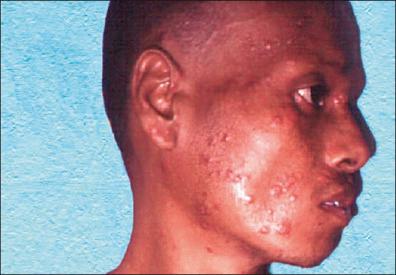
Many viral diseases that were not considered “tropical” 50 years ago are now much more frequently seen in immigrants from tropical countries, or in travelers who did not receive their recommended childhood vaccines. Three common examples are measles, rubella, and hepatitis B. Until the 1960s, measles and rubella were very common sources of infection in temperate countries, but in the 21st century they have become rare in industrialized countries, except for imported cases. Due to non-compliance with recommended vaccinations, however, 644 measles cases were reported in the US in 2014, the highest number in the 21st century. A single outbreak in early 2015, resulting from an infected person visiting Disneyland, California, resulted in 125 cases. Worldwide, however, almost one million children die of measles annually ( Fig. 1-5 ) and rubella still causes many congenital abnormalities. Measles is still the number one vaccine-preventable killer of children in the world. Morbidity and mortality are often the result of secondary bacterial infections developing in malnourished infants with measles ( Fig. 1-6 ). In east Asia, sub-Saharan Africa, and many other parts of the tropical world, hepatitis B is very common and a major source of morbidity and mortality. Although measles, rubella, and hepatitis B should not be a problem in the immunized traveler, many travelers have not received the proper immunizations because they or their parents had unfounded concerns about the safety of the vaccines. This problem continues to grow as more people reach child-bearing age without ever knowing anyone who has suffered from the childhood diseases common in the first half of the 20th century. Therefore, they do not understand that the approved vaccines are a million-fold safer than the diseases they are designed to prevent.
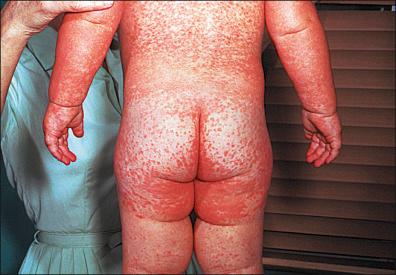
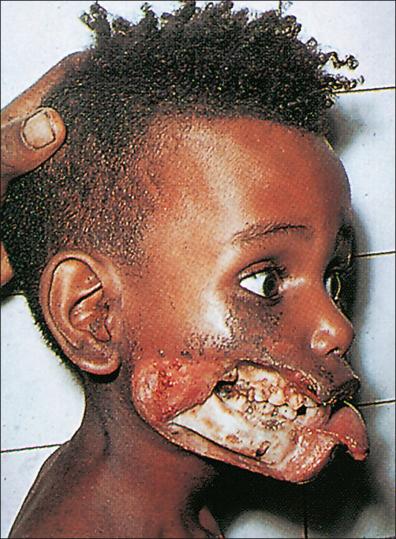
STDs should be considered at the top of the differential diagnoses when a patient presents with genital lesions and / or urogenital discharge. Although many of the same considerations would be true whether or not the patient was a recent traveler, certain factors should be given attention in travelers:
Was the person traveling without his / her spouse / family and therefore outside his / her usual social structure?
Did the person travel to countries where sex workers are readily available? Although sex workers are available in most parts of the world, legally or illegally, the traveler might be less likely to acquire an STD in Mecca during a haj than in Amsterdam, Bangkok, or Nairobi, where sex workers are very prevalent.
Did the person attend parties where large amounts of alcohol and / or drugs were consumed (e.g., “spring break” in the USA)?
If the traveler is strongly suspected of having an STD, did he / she visit a destination where chancroid, granuloma inguinale (GI), or lymphogranuloma venereum (LGV) (L serovars of Chlamydia trachomatis ) is prevalent? If so, the diagnostic tests and therapy might need to be expanded beyond those under consideration for STDs acquired in temperate lands.
When one STD is confirmed, there is an increased possibility of acquisition of additional STDs. Not only is this the case because the source partner(s) may have had multiple STDs, but also because having certain STDs makes a person more susceptible to other STDs. The best example of this phenomenon is the two- to fivefold greater risk of acquiring HIV if the person with a genital ulcer disease (GUD) has sex with an HIV-positive individual. The reasons for this increased risk include the reduced epithelial barrier in all GUDs, as well as the infiltrate of CD4+ cells in certain GUDs such as genital herpes. These CD4+ cells are the targets for HIV infection. Genital herpes is the most prevalent GUD in industrialized countries. In fact, the Centers for Disease Control and Prevention (CDC) estimate that there are 45 million herpes simplex virus type 2 (HSV-2)-seropositive persons in the USA. In the tropics, chancroid has been the most frequently diagnosed GUD, followed by syphilis and genital herpes, but the last two diseases are becoming more prevalent in certain tropical countries. Depending on the travel destination, LGV and GI must also be considered. The dates and duration of travel are important components of the history because the primary clinical presentation of all these GUDs ranges between 2 and 3 days (genital herpes and chancroid) and 4 weeks (syphilis and GI).
Currently, the World Health Organization (WHO) estimates that there are 46 million HIV-seropositive persons in the world. Many of these people have GUD, which may be changed both qualitatively and quantitatively by HIV. Therefore the traveler may have a “non-classical” presentation of GUD. In addition, it should be remembered that the signs and symptoms of GUD can also appear on the perianal area / buttock or in or around the mouth. Other locations are possible, but less likely.
In general, however, multiple painful, usually bilateral, vesicles that progress to ulcers on skin or start as ulcers on mucous membranes, then heal over after 3–4 weeks without therapy or within 2–3 weeks with antiviral therapy, are consistent with genital herpes. Because most true primary cases of genital herpes recur, a history of multiple recurrences of the vesicles or ulcers is highly consistent with genital herpes. This diagnosis can be confirmed by viral culture or serology. In the absence of these tools, a useful test is the Tzanck smear, which usually demonstrates multinucleated giant cells in herpetic lesions, but is of low sensitivity and specificity. Genital herpes, however, can present many diagnostic dilemmas because the first recognized clinical occurrence is often not the result of a recent infection but rather represents a first-episode, non-primary outbreak. Whereas a true primary outbreak of genital herpes is usually consistent with acquisition of the virus 2 days to 2 weeks previously, a first-episode, non-primary outbreak may be consistent with an infection at any time in the past. In this case, the patient's recent travel history may be of less importance than his / her sexual encounters of the more-distant past.
Although syphilis is much more common in many developing countries than in the USA, western Europe, or Australia, a lack of travel certainly does not exclude syphilis. This diagnosis should be suspected when the patient presents with a single, non-tender, genital, perianal, or lip ulcer associated with non-tender lymphadenopathy. Whereas chancroid is uncommonly reported in industrialized countries, it is very common in the tropics. It is usually characterized by one or more painful genital ulcers and painful lymphadenopathy. In LGV the primary lesion is usually very transient and is often not seen. The clinical presentation is usually that of tender inguinal lymphadenopathy, sometimes with a suppurating bubo. The diagnosis of GI is very rarely made outside the tropics. The presentation is usually that of one or more non-tender genital ulcers with inguinal swelling. If any of these bacterial GUDs is suspected, the appropriate diagnostic tests must be initiated (i.e., serology for syphilis and LGV, culture for chancroid and LGV, or tissue examination for GI) and the appropriate antibiotic started.
Whereas a history of multiple recurrences of genital vesicles or ulcers would be consistent with genital herpes, a more difficult scenario is represented by the patient who reports a single outbreak of non-specific genital signs and symptoms that are resolved by the clinic visit. A western blot or type-specific serologic test for HSV-2 would determine whether the person was infected with this virus, but it would not be definitive proof that that HSV-2 was responsible for the resolved outbreak. For example, a HSV-2 serologically positive person may acquire syphilis, but the genital ulcer may resolve without therapy, or with inadequate treatment, before the clinic visit at home. Thus, a careful history may reveal the need for serology for HSV-2 as well as for syphilis. Because HIV can be acquired concomitantly with or subsequently to these GUDs, but not produce genital manifestations, HIV testing should be conducted as well. Although many patients may be hesitant to admit sexual activity that puts them at risk for STDs, others will worry about these activities following travel (or any time) and ask to be tested for “everything.” If the sexual encounter with a new partner has been very recent, the serologic test may be false negative because serology for syphilis, HIV, or HSV-2 may require weeks to become positive in the majority of persons after initial infection.
Patients who ignore their primary genital lesions because of denial or difficulty finding medical care during their travels may believe that the problem is gone because the lesion has resolved. If syphilis is the cause of the GUD, it may reappear weeks or months later as non-genital cutaneous manifestations in the form of secondary (or tertiary) syphilis ( Fig. 1-7 ). A careful history regarding the primary lesion may lead to the appropriate diagnostic tests and therapy. Some STDs may not produce any genital signs or symptoms and the disease may be diagnosed long after the travel (or the non-travel acquisition), making it more difficult to find the source of the infection. Although over 90% of HIV-seropositive persons eventually develop indirect mucocutaneous manifestations of infection, the primary rash of seroconversion (if present) is not noticed by most patients. Therefore, the diagnosis is usually made when the patient develops systemic signs and symptoms (e.g., fever, chills, diarrhea, weight loss, lymphadenopathy) and / or develops one or more of the opportunistic infections, neoplasms, or inflammatory skin problems frequently seen in HIV patients. Similar to HIV, primary infection with hepatitis B rarely produces genital lesions. Diagnosis is usually made long after infection due to systemic symptoms or non-specific skin changes such as jaundice. Hepatitis B was the first STD for which a prophylactic vaccine was available. Therefore, a history of successful hepatitis B vaccination makes this diagnosis less likely. Fortunately, human papillomavirus (HPV) vaccines are now widely available, which can prevent up to nine of these sexually transmitted viruses.

Although the pustules of disseminated gonococcemia are distinctive, the consequences of untreated Neisseria gonorrhoeae (gonococcus) are usually pelvic inflammatory disease, epididymitis, proctitis, pharyngitis, or conjunctivitis. Pelvic inflammatory disease can also be caused by Chlamydia trachomatis (non-L serovars), Mycoplasma hominis , or various anaerobic bacteria. The non-L serovars of C. trachomatis can also cause epididymitis, proctitis, and conjunctivitis. Pharyngitis can also be due to HSV-2 or Entamoeba histolytica . The initial presentation of GC, C. trachomatis (non-L serovars), Ureaplasma urealyticum , Mycoplasma genitalium , Trichomonas vaginalis , or even HSV-2 may be urethritis. Vaginal discharge can be caused by any of these organisms as well as by Candida albicans , Gardnerella vaginalis , peptostreptococci, Bacteroides spp. or Mobiluncus spp. These organisms can usually be diagnosed by smear, wet-mount, DNA detection, serology, or culture. Antimicrobial therapy is usually initiated based on the physical examination and smear or wet-mount and modified, as needed, when other laboratory studies are completed.
Infection with HPV is one of the most common STDs in the world, but the clinical implications of the infection vary widely. There are over 20 HPV types that can cause genital lesions, but most infections do not result in any visible lesions. Because the incubation period of HPVs can be months, or even years, if and when genital lesions do develop, it is often very difficult for the patient to determine the source partner. Therefore, it is usually a challenge for the physician to relate HPV lesions to travel, especially recent travel. Non-oncogenic genital HPV, such as types 6 and 11, result in condyloma acuminatum, which can be treated with cytodestructive therapy, surgery, or with the immune response modifier imiquimod. Oncogenic genital HPV, such as types 16 and 18, can result in anogenital cancer, the most prevalent of which is cervical cancer. Cervical cancer is the second most prevalent cancer killer of women in the world and over 99% of all cervical cancer is caused by HPV. Most cervical cancer deaths are in tropical countries, making HPV one of the world's deadliest tropical diseases (although rarely listed with the other major tropical diseases). There are many reasons why more cervical cancer deaths occur in tropical countries. First, in industrialized countries most women receive regular Pap smears, which result in early detection and subsequent therapy of cervical abnormalities, thus reducing progression to cervical cancer. If cancer is detected, surgery, radiation therapy, or chemotherapy is available. In addition HPV vaccines are now widely available in most industrialized countries. In most tropical countries, regular Pap smears are not the standard of care. Therefore, cervical cancer is often detected too late for successful intervention, even if this is available. Second, there appears to be a genetic susceptibility that allows oncogenic HPV to progress to malignancy. This genetic susceptibility appears to be more prevalent in certain tropical countries. The rarity of male circumcision in many tropical countries appears to be a risk factor for the development of cervical cancer in these males' partners. Third, most of the world's estimated 46 million HIV-seropositive individuals live in tropical countries where no antiretroviral therapy is available. Not only is cervical cancer an acquired immunodeficiency syndrome (AIDS)-defining illness in HIV-seropositive women, but the same HPV can also cause anal cancer, which is a major problem in homosexual men with HIV.
Molluscum contagiosum (MC) is a poxvirus that can be sexually transmitted, resulting in wart-like lesions on the genitalia. In contrast to HPV, however, MC does not progress to malignancy. Like condyloma acuminatum, however, MC can be treated with cytodestructive therapy, surgery, or imiquimod.
Ectoparasites such as scabies, Sarcoptes scabiei , and pubic lice, Phthirus pubis , can be sexually transmitted. In contrast to many STDs, however, these ectoparasites can be easily treated with topical medications such as lindane or permethrin. Like all STDs, if the sexual partner is not treated concomitantly then reinfection is common.
The most common cause of fever after tropical travel is malaria, which usually does not have specific cutaneous manifestations. Dengue fever is the second most common cause of fever in the traveler and does have somewhat specific cutaneous manifestations, making dengue fever the leading cause of fever with rash in the traveler returning from a tropical destination ( Fig. 1-8 ). Other common causes of fever and rash include hepatitis viruses, rickettsia, and some enteric fevers. It should always be kept in mind, however, that fever in the returned traveler may not be due to exposure during travel. For example, the fatigue of travel (i.e., jet lag) may make one more susceptible to influenza or other common infections in temperate lands.

When both fever and rash are seen, the time between travel and onset of signs and symptoms becomes increasingly important. If travel preceded fever and rash by less than 1–2 weeks, considerations should include anthrax, dengue fever, diphtheria, ehrlichiosis, hemorrhagic fever viruses, leptospirosis, Lyme disease, measles, meningococcal infections, plague, rickettsia, toxoplasmosis, trichinosis, tularemia, typhoid fever, and yellow fever. If the period between travel and fever / rash is up to a month, the list should be expanded to include hepatitis viruses (A, C, and E), HIV, rubella, schistosomiasis, and trypanosomiasis. If at least 3 months separate travel from fever / rash, the following infections should be considered: bartonellosis, filariasis, gnathostomiasis, hepatitis viruses (B and C), histoplasmosis, HIV, leishmaniasis, Lyme disease, melioidosis, penicilliosis, syphilis, trypanosomiasis, and tuberculosis. In each case, however, the nature of the fever, the type of rash, the destination of the travel, and any other symptoms must be considered.
Because many infections producing fever with rash can be rapidly fatal and / or easily spread, it is imperative to initiate immediately diagnostic tests and antimicrobial therapy for the presumed cause of the infection. Such infections include anthrax, bartonellosis, Candida (macronodules), diphtheria, disseminated gonorrhoeae (papules and pustules over joints), hepatitis viruses, leptospirosis, meningitis (asymmetrical, scattered, petechiae, and purpura), plague, Pseudomonas (ecthyma gangrenosum), relapsing fevers, rickettsia (scattered petechiae and purpura), Staphylococcus (Osler's nodes, diffuse toxic erythema), Streptococcus (Janeway lesions, diffuse toxic erythema), Strongyloides (migratory petechiae and purpura), syphilis, tuberculosis, typhoid fever (rose spots) ( Fig. 1-9 ), various Gram-negative bacteria (i.e., peripheral gangrene), Vibrio (especially V. vulnificus ), and viral hemorrhagic fevers (petechiae, purpura, hemorrhage).
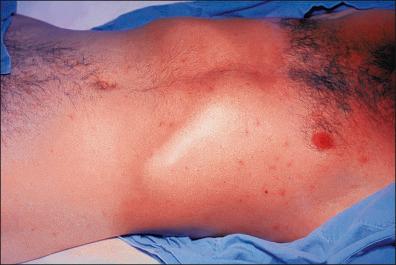
Eosinophilia may be due to diverse processes, such as allergic, neoplastic, and infectious diseases. Although an allergic reaction could easily result from an exposure during travel, eosinophilia in the returned traveler may have nothing directly to do with the travel. On the other hand, it may be due to an infectious process or to a drug taken for prophylaxis or therapy during travel. If an infection is the cause of the eosinophilia, it is usually a parasitic disease, especially that due to a helminth. Only a few viral, bacterial, or fungal diseases are associated with both rash and eosinophilia, for example, streptococcal fever (i.e., scarlet fever), tuberculosis, HIV, and coccidioidomycosis. Protozoa only rarely provoke eosinophilia.
The principal helminth that causes eosinophilia is Strongyloides . When Strongyloides is disseminated, such as in the hyperinfection syndrome, skin lesions such as urticaria, papules, vesicles, petechiae, and migratory serpiginous lesions become common, especially if the patient is given systemic corticosteroids (because Strongyloides was not considered).
Pruritic, erythematous papules can be seen as a result of schistosomal cercariae, as in swimmer's itch. Eosinophils may be seen in the skin biopsy as well as in the blood.
Pruritic lesions of the skin and subcutaneous tissues are commonly associated with eosinophilia in onchocerciasis. Lymphangitis, orchitis, and epididymitis are also commonly observed.
In loiasis, fever and eosinophilia are typically seen. Migratory lesions, especially angioedema, are usually erythematous and pruritic.
Likewise, gnathostomiasis produces recurrent edema after ingestion of raw fish. The skin lesions are usually erythematous, pruritic, and / or painful.
Drug hypersensitivity is a relatively common cause of eosinophilia and may be associated with non-specific skin changes, such as urticaria and / or phototoxic reactions. Although most drugs that cause eosinophilia may not be taken for purposes related to traveling, increased sun exposure during travel may make the problem clinically apparent. Because antibiotics may be taken for prophylaxis or therapy more frequently during traveling, they should be given careful consideration when eosinophilia is detected. Such antibiotics include penicillins, cephalosporins, quinolones, isoniazid, rifampin, and trimethoprim-sulfamethoxazole.
Become a Clinical Tree membership for Full access and enjoy Unlimited articles
If you are a member. Log in here